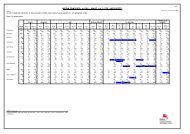WHAT CHILDREN WATCH - Ofcom
WHAT CHILDREN WATCH - Ofcom
WHAT CHILDREN WATCH - Ofcom
You also want an ePaper? Increase the reach of your titles
YUMPU automatically turns print PDFs into web optimized ePapers that Google loves.
Executive Summary<br />
1. Households with children living in them contain a wider range of in-home<br />
entertainment than childfree households and are more likely to be ‘early adopters’<br />
of such equipment.<br />
2. Children in multichannel homes watch significantly more television per day than their<br />
terrestrial only counterparts (an average of 35 minutes more per day at 2 hours and<br />
27 minutes). However, the amount of time they spend specifically viewing ‘children’s<br />
programmes’ is comparable with those living in analogue terrestrial-only homes<br />
[Source: BARB].<br />
3. There has been a dramatic rise in the amount of children’s programming on analogue<br />
terrestrial and other television services over the past five years.<br />
4. The increase has come about principally from the launch of the new analogue terrestrial<br />
service Five (formerly operating as Channel 5), as well as the introduction of dedicated<br />
satellite and cable-delivered channels. (The detailed analyses do not include the free-toair<br />
dedicated children’s channels, CBBC and CBeebies, launched after the analysis period<br />
in February 2002, increasing provision still further.)<br />
5. Children are able now to tune in to children’s programmes on the dedicated channels at<br />
any time of day. The replay channels which offer rolling schedules, available in<br />
multichannel homes, mean that children in these homes need not worry about missing<br />
their favourite programmes, as they will be repeated.<br />
6. Despite this growth in provision, the range being offered to children, as a proportion of<br />
the time devoted to children’s programming, is variable on different services. In this<br />
context, analogue terrestrial channels offer the most diverse line-up with regard to the<br />
balance of different types of programming e.g. factual, drama, light entertainment,<br />
animation and pre-school, broadcast on a single channel.<br />
7. This being said, the mainstay of the analogue terrestrial channels is animation, as it is<br />
for the dedicated children’s channels. The analyses do not distinguish between types of<br />
animation and, not surprisingly, this is the genre which most children are watching<br />
within children’s programming. In multichannel homes, more than half the time spent<br />
viewing children’s programmes is devoted to this genre.<br />
8. The result of this dramatic increase in animation is a move away, by children in<br />
multichannel homes in particular, from the drama and factual genres in children’s<br />
programming.<br />
9. The provision of drama on the analogue terrestrial channels is more stable than some of<br />
the other genres, with little significant change across the period sampled. On the<br />
dedicated channels, however, there was a steep decline in drama in 2001.<br />
What Children Watch 1

















